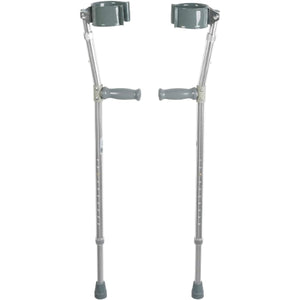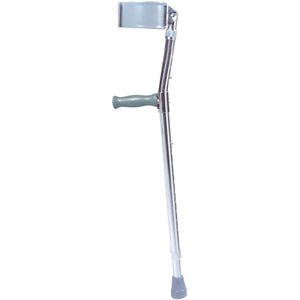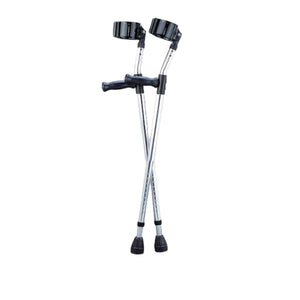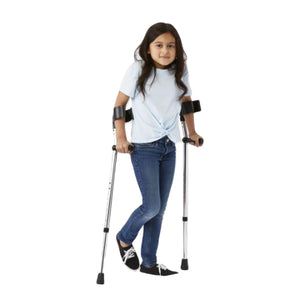Learning how to use crutches on stairs safely is essential for individuals recovering from leg injuries, post-surgery limitations, or chronic mobility issues. At Moovkart, we’re committed to ensuring that you feel confident, safe, and supported in every step of your recovery journey. This step-by-step guide to using crutches on stairs includes practical advice, crutch techniques for stairs with no handrail, and safety tips for the elderly using crutches on steps.
- Always use the stronger leg first when going up, and the weaker leg first when going down.
- Hold the handrail when available; place both crutches under one arm if needed.
- If no handrail is present, use both crutches and follow a slow, careful pace.
- Follow Moovkart’s guide for using crutches indoors and outdoors to prevent falls.
- Consult your healthcare provider for personalized stair safety techniques.
Introduction
Whether you're recovering from surgery or an injury, using crutches can feel overwhelming, especially when it comes to navigating stairs. Knowing the best way to go up and down stairs with crutches can prevent dangerous accidents and speed up recovery. This blog offers a complete breakdown of techniques, tips, and tricks to climb or descend stairs—whether you’re using a handrail or not. By following this Moovkart guide for using crutches indoors and on staircases, you’ll gain mobility and confidence.
10 Steps to Follow for Using Crutches on Stairs
1. Assess the Stair Environment
Check whether a handrail is present. A handrail provides additional support, making it easier to apply the correct crutch technique for stairs with no handrail if unavailable.
2. Position Yourself Correctly
Stand close to the stairs, with your crutches placed slightly in front of you. Ensure a firm grip on the handles and pads.
3. Going Up: Lead with Your Stronger Leg
The general rule is “up with the good.” Your stronger leg should take the first step, followed by your weaker leg and crutches.
4. Going Down: Lead with Your Injured Leg and Crutches
The opposite applies when descending—“down with the bad.” Move your crutches down to the next step, then your injured leg, and finally the stronger leg.
5. Using a Handrail
If a handrail is available, place both crutches under one arm (usually the side of the injured leg), and use the rail with your free hand for balance and support.
6. Without a Handrail
Use both crutches simultaneously to maintain stability. This is where proper crutch placement on stairs becomes essential. Take small, deliberate steps to ensure balance.
7. Take Your Time
Never rush. The best way to go up and down stairs with crutches is to stay calm and steady. Use each step as a checkpoint for safety.
8. Rest When Needed
Fatigue can increase your risk of falling. Pause at landings or before taking another flight of stairs. Use this moment to assess your strength and breath.
9. Practice Regularly
Use our instructional video for using crutches on stairs to practice at home or in a rehab center. The more you repeat these steps, the more confident you become.
10. Ask for Assistance
If you're unsure or unsteady, don't hesitate to ask for help. Caregivers or therapists can offer guidance or physical support during difficult stair climbs.
Key Tips and Safety Measures
Proper Crutch Placement
Always place the crutch tips about 6 inches in front and to the side of each foot. This triangular stance improves balance.
Tips for Climbing Stairs with One Leg in Cast
If one leg is immobilized, rely heavily on your upper body strength. Your crutches must support most of your weight. When descending, your casted leg should follow the crutches, not precede them.
How to Go Downstairs with Crutches After Surgery
Place your crutches on the lower step first, then your operated leg. Lastly, bring down your stronger leg. Using proper technique here is crucial for healing.
Safety Tips for Elderly Using Crutches on Steps
Wear non-slip footwear, avoid loose rugs near stairs, and install stair railings or grab bars. Make sure the crutches have proper rubber tips to avoid slipping.
Use the Moovkart Indoor Safety Guide
For enhanced safety at home, follow our Moovkart guide for using crutches indoors. It includes spacing recommendations, flooring choices, and home layout tips for crutch users.
Who Can Benefit from This Guide?
- Post-operative patients recovering from knee, ankle, or foot surgery
- Individuals with leg fractures using crutches temporarily
- Elderly patients with limited mobility navigating stairs independently
- Caregivers and physiotherapists guiding patients in mobility training
- Anyone using crutches indoors in multi-floor homes or apartments
Frequently Asked Questions (FAQs)
What is the safest way to go upstairs with crutches?
Always lead with your stronger leg while holding the handrail if available. Follow with the weaker leg and then crutches. This reduces pressure on the injured limb.
How do I go downstairs with crutches after surgery?
Lead with your crutches and the weaker leg, followed by the stronger leg. Hold onto the handrail for additional stability.
What if there is no handrail available?
If a handrail is not available, use both crutches equally spaced for balance. Place both crutches on the next step, step down with the injured leg, and then bring down the stronger leg.
Can I use stairs if I have a full leg cast?
Yes, but only with proper training and assistance. You'll need to use the crutches to bear most of your weight and take one stair at a time carefully.
Is there a video I can follow to practice this technique?
Yes. Moovkart provides an instructional video for using crutches on stairs as part of our patient education content. It demonstrates the entire process in real-time.
What should caregivers know about helping someone with crutches on stairs?
Caregivers should always stay close, especially on the descent. Spot from behind when ascending and from the front when descending, without pulling or pushing the patient.
Conclusion
Using crutches on stairs doesn't have to be intimidating. With the right knowledge, preparation, and practice, anyone can learn the step-by-step guide to using crutches on stairs safely. Always prioritize proper crutch placement on stairs and remember: “Up with the good, down with the bad.” Whether you're dealing with a cast, recovering post-surgery, or assisting a loved one, these proven tips can greatly reduce your risk of injury.
Explore more mobility and safety aids at Moovkart. We're here to help you walk with confidence, one step at a time.





